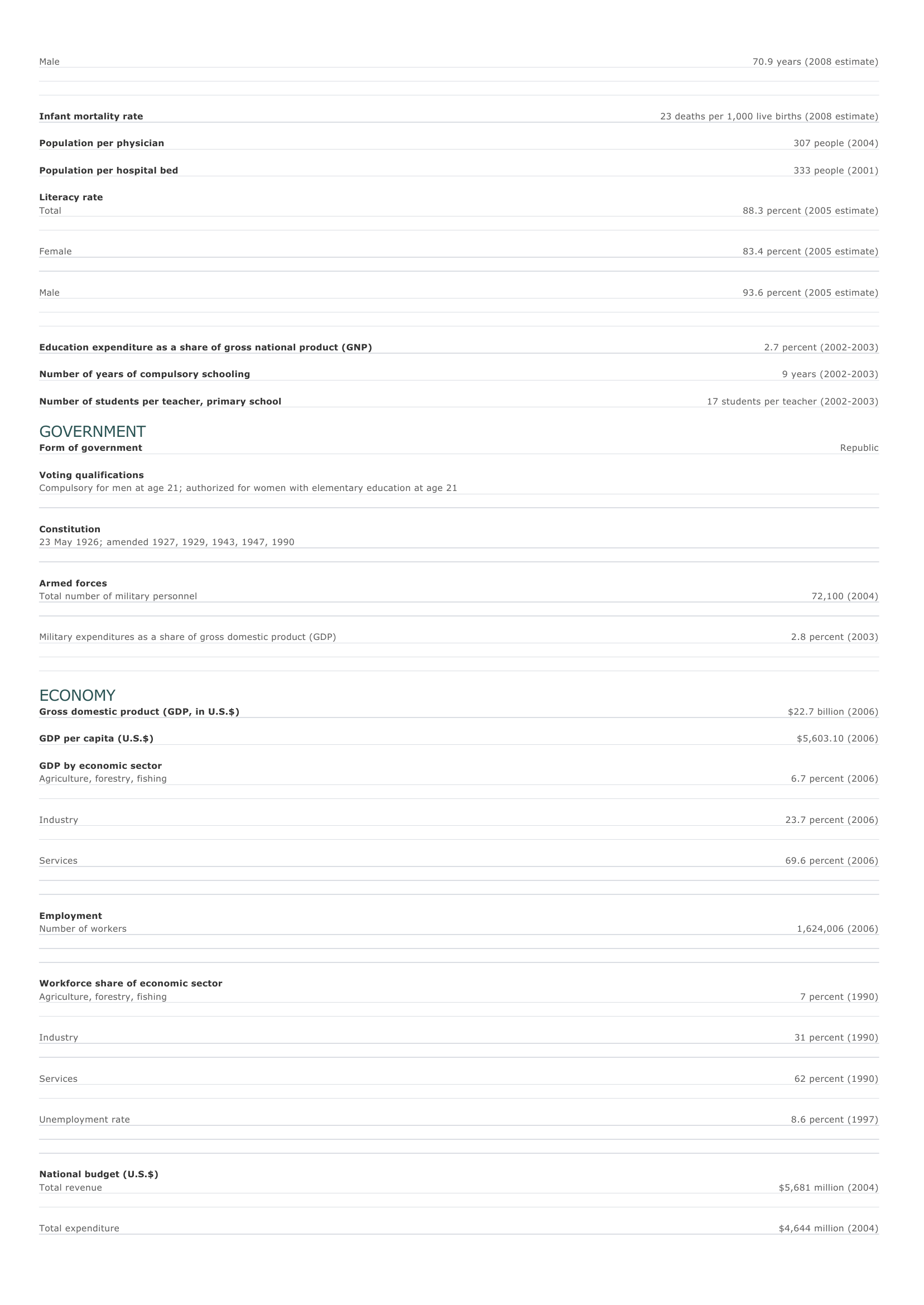Lebanon Facts and Figures. BASIC FACTS Official name Capital Area Republic of Lebanon Beirut 10,452 sq km 4,036 sq mi PEOPLE Population 3,971,941 (2008 estimate) Population growth Population growth rate 1.15 percent (2008 estimate) Projected population in 2025 4,569,812 (2025 estimate) Projected population in 2050 4,964,025 (2050 estimate) Population density 388 persons per sq km (2008 estimate) 1,006 persons per sq mi (2008 estimate) Urban/rural distribution Share urban 88 percent (2005 estimate) Share rural 12 percent (2005 estimate) Largest cities, with population Beirut 1,792,000 (2003 estimate) Tripoli 212,900 (2003 estimate) ??r 117,100 (2003 estimate) ? ayd? 149,000 (2003 estimate) Ethnic groups Arab 93 percent A rmenian 5 percent O ther 2 percent Languages Arabic (official), French, Armenian, English Religious affiliations Muslim 70 percent (5 legally recognized Islamic groups: Shia, Sunni, Alawite, Druze, Isma'ilite) Christian 30 percent (11 legally recognized Christian groups: 4 Orthodox Christian, 6 Catholic, 1 Protestant) HEALTH AND EDUCATION Life expectancy Total Female 73.4 years (2008 estimate) 76 years (2008 estimate) Male Infant mortality rate 70.9 years (2008 estimate) 23 deaths per 1,000 live births (2008 estimate) Population per physician 307 people (2004) Population per hospital bed 333 people (2001) Literacy rate Total 88.3 percent (2005 estimate) Female 83.4 percent (2005 estimate) Male 93.6 percent (2005 estimate) Education expenditure as a share of gross national product (GNP) Number of years of compulsory schooling Number of students per teacher, primary school 2.7 percent (2002-2003) 9 years (2002-2003) 17 students per teacher (2002-2003) GOVERNMENT Form of government Republic Voting qualifications Compulsory for men at age 21; authorized for women with elementary education at age 21 Constitution 23 May 1926; amended 1927, 1929, 1943, 1947, 1990 Armed forces Total number of military personnel Military expenditures as a share of gross domestic product (GDP) 72,100 (2004) 2.8 percent (2003) ECONOMY Gross domestic product (GDP, in U.S.$) GDP per capita (U.S.$) $22.7 billion (2006) $5,603.10 (2006) GDP by economic sector Agriculture, forestry, fishing 6.7 percent (2006) I ndustry 23.7 percent (2006) Services 69.6 percent (2006) Employment Number of workers Workforce share of economic sector Agriculture, forestry, fishing 1,624,006 (2006) 7 percent (1990) I ndustry 31 percent (1990) Services 62 percent (1990) Unemployment rate 8.6 percent (1997) National budget (U.S.$) Total revenue $5,681 million (2004) Total expenditure $4,644 million (2004) Monetary unit 1 Lebanese pound (£L), consisting of 100 piastres Major trade partners for exports United Arab Emirates, France, Switzerland, United States, and Saudi Arabia Major trade partners for imports Italy, France, Germany, United States, and Syria ENERGY, COMMUNICATIONS, AND TRANSPORTATION Electricity production Electricity from thermal sources Electricity from hydroelectric sources 90.63 percent (2003 estimate) 9.37 percent (2003 estimate) Electricity from nuclear sources 0 percent (2003 estimate) Electricity from geothermal, solar, and wind sources 0 percent (2003 estimate) Number of radios per 1,000 people 907 (1997) Number of telephones per 1,000 people 277 (2005) Number of televisions per 1,000 people 323 (2000 estimate) Number of Internet hosts per 10,000 people 22 (2003) Daily newspaper circulation per 1,000 people 141 (1996) Number of motor vehicles per 1,000 people 336 (1997) Paved road as a share of total roads 85 percent (1999) SOURCES Basic Facts and People sections Area data are from the statistical bureaus of individual countries. Population, population growth rate, and population projections are from the United States Census Bureau, International Programs Center, International Data Base (IDB) (www.census.gov). Urban and rural population data are from the Food and Agriculture Organization (FAO) of the United Nations (UN), FAOSTAT database (www.fao.org). Largest cities population data and political divisions data are from the statistical bureaus of individual countries. Ethnic divisions and religion data are largely from the latest Central Intelligence Agency (CIA) World Factbook and from various country censuses and reports. Language data are largely from the Ethnologue, Languages of the World, Summer Institute of Linguistics International (www.sil.org). Health and Education section Life expectancy and infant mortality data are from the United States Census Bureau, International Programs Center, International database (IDB) (www.census.gov). Population per physician and population per hospital bed data are from the World Health Organization (WHO) (www.who.int). Education data are from the United Nations Educational, Scientific and Cultural Organization (UNESCO) database (www.unesco.org). Government section Government, independence, legislature, constitution, highest court, and voting qualifications data are largely from various government Web sites, the latest Europa World Yearbook, and the latest Central Intelligence Agency (CIA) World Factbook. The armed forces data is from Military Balance. Economy section Gross domestic product (GDP), GDP per capita, GDP by economic sectors, employment, and national budget data are from the World Bank database (www.worldbank.org). Monetary unit, agriculture, mining, manufacturing, exports, imports, and major trade partner information is from the statistical bureaus of individual countries, latest Europa World Yearbook, and various United Nations and International Monetary Fund (IMF) publications. Energy, Communication, and Transportation section Electricity information is from the Energy Information Administration (EIA) database (www.eia.doe.gov). Radio, telephone, television, and newspaper information is from the United Nations Educational, Scientific and Cultural Organization (UNESCO) database (www.unesco.org). Internet hosts, motor vehicles, and road data are from the World Bank database (www.worldbank.org). Note Figures may not total 100 percent due to rounding. Microsoft ® Encarta ® 2009. © 1993-2008 Microsoft Corporation. All rights reserved.

































